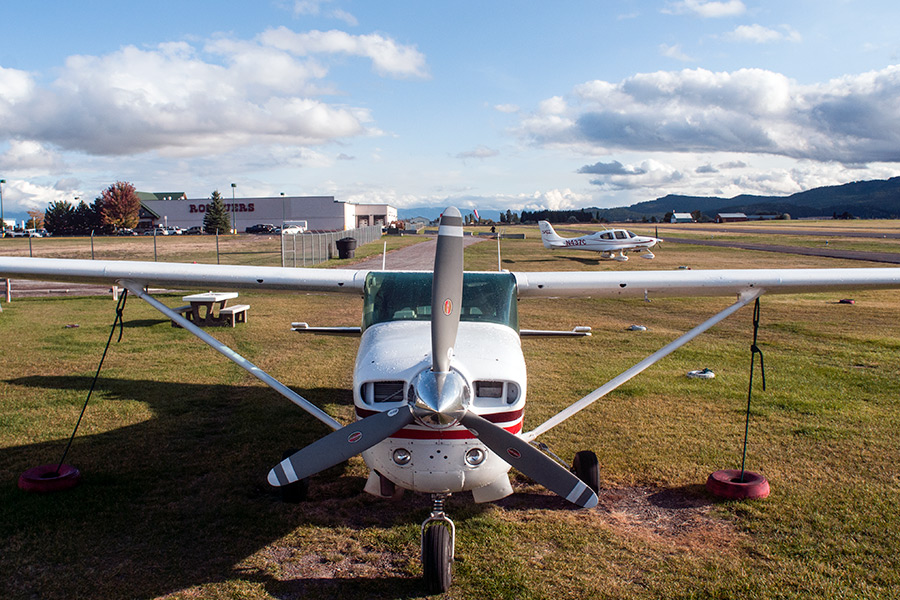A community park with an area for dog owners and pets.
An expanded trail system with a park-n-ride trailhead.
Redevelopment for mixed-use housing, light industrial and commercial businesses.
A new vision for the southern end of Kalispell is taking shape, driven by public input and crafted by a team of planners over the last 12 months.
The new 88-page urban renewal blueprint, unveiled earlier this month and presented last week to nearly 30 community members at an open house in city hall, envisions $61 million worth of investment and revitalization in a 722-acre chunk of land at Kalispell’s south corridor. It lists improvement options, such as upgrading Cemetery Road and relocating the city shops near Legends Stadium, and proposes added green space and business amenities.
The new plan also revives one of the city’s long-lasting debates that will play a pivotal role in the area’s evolution.
“The heart of the matter is what to do with the airport,” Wayne Freeman, a planner and project leader with CTA Architects Engineers, which developed the south Kalispell plan, told the crowd in city hall.
Six major planning efforts since 1979 have grappled with the 71-acre city airport along U.S. 93 and its galvanizing role in the community. None have been able to properly solve the lingering conundrum, bringing the Kalispell City Council back to a familiar crossroads.
The city council is expected to review the plan in the coming months.
CTA developed five alternative strategies for the airport — keep it as is using city funding; close the airport; request FAA funding for the airport in its current alignment; incorporate an airport authority that oversees the site; and privatize the airport.
CTA gathered over 100 responses from community members and stakeholders at public meetings and online — 42 percent were in favor of keeping the airport in its current configuration; 32 percent wanted to bring it into FAA compliance; and 26 percent wanted to phase out airport operations.
The city has balked at making any capital improvements or investments into the site in recent years. The FAA in the past has proposed funding for improvements and updates at the site, but voters in 2013 rejected the upgrades through a ballot referendum.
Now in its current standing the 87-year-old airport is outdated, plagued with deferred maintenance and stricken with safety issues, according to both the FAA and CTA’s study.
It also loses money annually. The airport operated at an average net loss of $99,499 per year from 2010 to 2014, according to CTA. That includes depreciation, which is not a direct cash expense but instead represents the decline in value of an asset that has already been paid for. There is roughly $1 million worth of depreciable assets at the airport, according to city records. If depreciation is not included, the airport had positive cash flow in 2010 and 2013 and operated at an average net loss of $124 from 2010 to 2014, according to CTA. The positive cash flows were caused by irregular events, including a one-time contribution from a local government fund of $92,625 in 2013, and not by normal revenues exceeding expenses. CTA planners are recommending that the city not include depreciation in its financial analysis to “present a more accurate picture of operating expenses and revenues.”
Under the first option — keeping the airport as is — the city would tackle necessary capital improvements that need to be made, CTA says. There is available property that could be leased to generate new revenue. Under this alternative and depending on the new revenue opportunities, the airport would most likely remain unprofitable.
Closing the airport “has the possibility of being a complicated and costly alternative,” CTA stated. It would cost the city an estimated $2.9 million to buy out the on-site leases. The firm projected that the city would not generate enough revenue from the sale of the airport land to cover the costs associated with selling; however it could generate new tax revenue. The city could tap into its tax increment finance fund to pay for demolition costs.
The third alternative — bringing the airport into FAA compliance without expanding it — is CTA’s recommended course of action “if the city has the political willingness to pursue” it. This alternative would be similar to the first option but would put more of the financial burden for capital improvements on the FAA. The city would have to re-engage with the agency and work out an agreement that gains funding without following the previous upgrade plan that voters rejected. The initial investment cost for the city would be $400,000. Some of these funds could come from the TIF for development projects, while maintenance projects would be ineligible for TIF funding, CTA said.
“What was made clear during the analysis is that this general aviation airport cannot sustain itself without full development of available property, and FAA participation in capital improvement projects. Without FAA participation in capital projects, the Airport operates at a loss even with full development of revenue producing property,” CTA states in its report.
The firm added, “If the city wishes to keep the Airport an active and viable community asset there will need to be a concerted political decision and financial commitment from the City.”
To read the report, visit http://southkalispellurbanrenewal.com.
